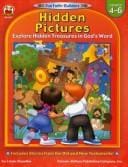Hidden Pictures: The Timeless Puzzle That Boosts Brain Power and Delight
Explore Hidden Pictures puzzles—learn their history, brain-boosting benefits, solving tips, and the best books and apps for all ages.

What Are Hidden Pictures?
Hidden Pictures are illustrated scenes that secretly conceal smaller objects, animals, or symbols within the larger artwork. The challenge for the player is to locate each item, often listed in a key beside or below the illustration. Unlike jigsaw puzzles, where the goal is assembly, Hidden Pictures require keen observation, pattern recognition, and sustained focus to pick out camouflaged shapes that seamlessly blend with their surroundings.
A Brief History
The concept of embedding objects inside drawings is older than most people think. Early examples can be traced back to the 19th century, when European newspapers published satirical cartoons hiding political figures among the crowds. In 1946, the children’s magazine "Highlights for Children" popularized the format in North America, introducing a recurring feature simply called “Hidden Pictures.” These black-and-white spreads charmed generations of young readers and quickly became the magazine’s best-loved page. Over the decades, the idea evolved, moving from periodicals to stand-alone puzzle books, educational worksheets, and now to interactive apps.
Cognitive Benefits
Finding hidden objects might feel like pure play, yet research in cognitive psychology shows that the activity engages several brain regions simultaneously. Visual search tasks stimulate the parietal lobe, responsible for spatial awareness, while sustained attention strengthens neural pathways linked to the prefrontal cortex. Regularly completing Hidden Pictures can improve:
• Concentration and sustained attention
• Visual discrimination skills
• Short-term memory
• Problem-solving flexibility
Educators often use these puzzles in classrooms to support early reading readiness. By tracking shapes, children practice scanning left to right—mirroring the motion of reading. Seniors can also benefit; engaging in visual puzzles may slow cognitive decline by maintaining neural plasticity.
Why Hidden Pictures Appeal to All Ages
1. Instant Gratification: Each discovery releases a small burst of dopamine, giving solvers an immediate sense of accomplishment.
2. Low Barrier to Entry: No elaborate rules or equipment are needed—only eyes and curiosity.
3. Portability: They fit neatly into magazines, smartphone screens, or printable sheets.
4. Cooperative Play: Families or classrooms can solve together, fostering teamwork and communication.
Because the puzzles scale in complexity—from a handful of large objects for preschoolers to dozens of miniature shapes for adults—they offer an inclusive pastime that grows with skill level.
How to Solve Hidden Pictures Like a Pro
Even seasoned puzzle lovers sometimes overlook the obvious. The following strategies can raise your hit rate and reduce frustration:
Start with the silhouette list. Many puzzles provide outlines of the hidden objects. Train your brain to memorize the contours before you search.
Scan systematically. Divide the illustration into quadrants and comb each section left to right, top to bottom.
Change your vantage point. Rotate the page or the tablet to break perceptual set and reveal disguised images.
Look for mismatched textures. An umbrella handle may masquerade as a tree branch, yet the straight, smooth line often betrays it.
Take micro-breaks. Glancing away for thirty seconds refreshes visual receptors and renews focus.
Modern Takes: Digital Apps and Interactive Books
The digital boom has reimagined Hidden Pictures for touch screens. Interactive highlights, animations, and sound effects amplify the thrill of discovery. Popular apps such as “Highlights Hidden Pictures,” “Seekers Notes,” and “Hidden Folks” let users tap on items, triggering celebratory chimes or clever reactions within the scene. Adaptive difficulty settings personalize the experience, making puzzles progressively harder as accuracy improves.
E-books add additional layers such as timed challenges, progress tracking, and community leaderboards that motivate solvers to return daily. The virtual format also supports color-blind modes, pinch-to-zoom functionality, and night themes, widening accessibility.
DIY Hidden Picture Activities
You don’t need professional illustration skills to craft a captivating puzzle at home or in the classroom.
Step 1: Choose a Theme. Popular options include seasonal scenes, favorite sports, or zoo adventures.
Step 2: Sketch a Busy Background. The more visual noise, the easier it is to camouflage objects.
Step 3: Pick Ten Everyday Items. Think scissors, spoon, or star. Draw each item first, then weave it into the larger scene by altering scale and orientation.
Step 4: Ink and Color. Bold outlines help the foreground pop while toning down hidden shapes in similar hues keeps them subtle.
Step 5: Test. Hand the puzzle to a friend; adjust any items they find too easily or not at all.
Creating your own Hidden Pictures fosters creativity and teaches lessons in composition, contrast, and audience feedback—a useful art project for students.
Conclusion
Hidden Pictures have journeyed from Victorian caricatures to glossy magazines and now vibrant apps, yet their basic appeal endures. They challenge our eyes, sharpen our minds, and deliver a burst of joy each time a cleverly disguised object comes to light. Whether you are a parent looking for screen-free entertainment, a teacher seeking engaging classroom resources, or an adult longing for a mindful break, adding Hidden Pictures to your routine is a simple way to combine fun with cognitive fitness.